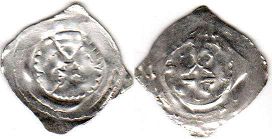Coins of Styria - catalog with values
Duchy of Styria (Steiermark)
Kreuzr=4 pfennig; Pfennig=2 heller
Alert (Albrecht) I king of Germany since 1298 (1282-1308)

pfennig
silver
Coin value ~ 80-100 USD
Costs of Styria coins in this catalog approximate and indicated specifically for the coin shown in the picture.
I do not buy or sell coins - this is just a catalog.

